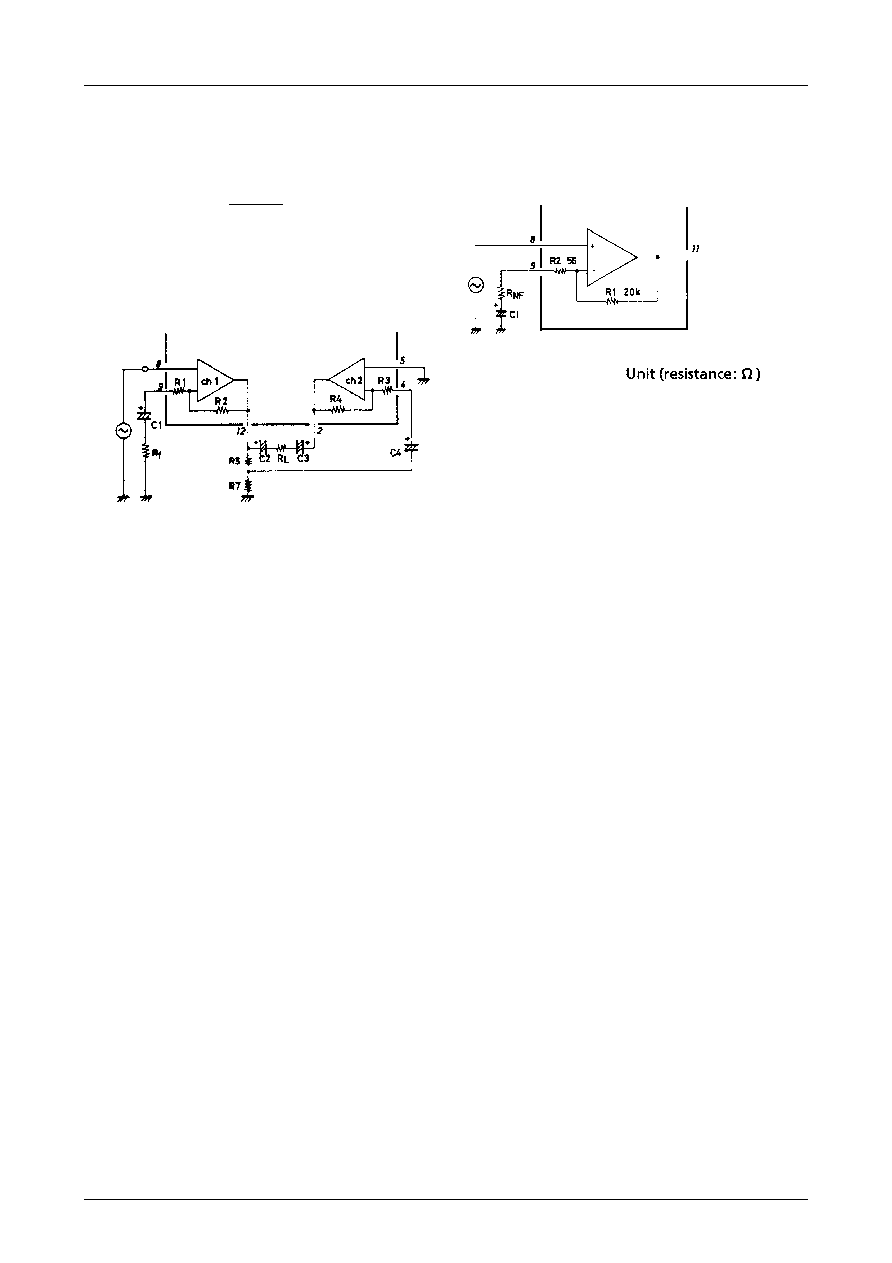- 您現(xiàn)在的位置:買賣IC網(wǎng) > PDF目錄30718 > LA4557 2.4 W, 2 CHANNEL, AUDIO AMPLIFIER, PDIP12 PDF資料下載
參數(shù)資料
| 型號: | LA4557 |
| 元件分類: | 音頻/視頻放大 |
| 英文描述: | 2.4 W, 2 CHANNEL, AUDIO AMPLIFIER, PDIP12 |
| 封裝: | DIP-12 |
| 文件頁數(shù): | 4/9頁 |
| 文件大小: | 334K |
| 代理商: | LA4557 |

LA4557
No.2087–4/9
Application Circuits
Voltage gain adjust
Stereo mode
The voltage gain is determined by on-chip resistor R1 (R2) and external feedback resistor RNF as follows :
Any voltage gain can be obtained by external
resistor RNF.
Bridge amplifier 1 mode
The CH1 is a noninverting amplifer and the CH2 is an inverting amplifier. The total voltage gain, being apparently
higher than that of the CH1 by 6dB, is approximately calculated by the following formura.
VG=20log R2/R1+6 (dB)
To reduce the voltage gain, Rf is connected and the following formura is used.
VG=20log R2/Rf=R1+6 (dB)
Proper cares in using LA4557-applied set
1. Slider contact noise of variable resistor
Since the input circuit uses PNP transistors, no input coupling capacitor is required. However, if slider contact noise
of the variable resistor presents any problem, connect a capacitor in series with input.
2. Pop noise
If pop noise generated at the time of power ON/OFF disturbs you, connect a resistor of 500
to 1k across the
middle point and GND.
Thermal Design
Since the DIP12F package is such that the Cu-foiled area of the printed circuit board is used to dissipate heat, make the
Cu-foiled area in the vicinity of the heat sink of the IC as large as possible when designing the printed circuit board.
Power dissipation Pd is increased depending on the supply voltage and load. So, it is recommended to use the printed
circuit board together with the heat sink. The following is a formula to be used to calculate Pd (for stereo use). For AC
power supply, however, it is recommended to actually measure Pd on the transformer of each set. For bridge amplifier
use, Pd is calculated at 1/2 of the load.
VG=20 log
[dB]
R1
RNF+R2
相關(guān)PDF資料 |
PDF描述 |
|---|---|
| LA4558 | 2.4 W, 2 CHANNEL, AUDIO AMPLIFIER, PDIP12 |
| LA4571MB | 0.032 W, 2 CHANNEL, AUDIO AMPLIFIER, PDSO20 |
| LA4571MB | 0.032 W, 2 CHANNEL, AUDIO AMPLIFIER, PDSO20 |
| LA4575 | 0.038 W, 2 CHANNEL, AUDIO AMPLIFIER, PDIP16 |
| LA4575M | 0.038 W, 2 CHANNEL, AUDIO AMPLIFIER, PDSO16 |
相關(guān)代理商/技術(shù)參數(shù) |
參數(shù)描述 |
|---|---|
| LA4558 | 制造商:Panasonic Industrial Company 功能描述:IC |
| LA4560M | 制造商:未知廠家 制造商全稱:未知廠家 功能描述:Analog IC |
| LA4570 | 制造商:未知廠家 制造商全稱:未知廠家 功能描述:Analog IC |
| LA4570M | 制造商:未知廠家 制造商全稱:未知廠家 功能描述:Analog IC |
| LA4571 | 制造商:未知廠家 制造商全稱:未知廠家 功能描述: |
發(fā)布緊急采購,3分鐘左右您將得到回復(fù)。